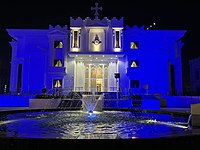
Back Assiriese Kerk van die Ooste Afrikaans كنيسة المشرق الآشورية Arabic ܥܕܬܐ ܕܡܕܢܚܐ ܕܐܬܘܪܝܐ ARC كنيسة المشرق الاشوريه ARZ Асірыйская Царква Усходу Byelorussian Асырыйская царква Ўсходу BE-X-OLD Асирийска източна църква Bulgarian পূর্বদেশীয় অশূরীয় মণ্ডলী Bengali/Bangla Església Assíria Oriental Catalan Asyrská církev Východu Czech
 Holy Apostolic Catholic Assyrian Church of the East | |
|---|---|
 | |
| Abbreviation | ACOE |
| Classification | Eastern Christian |
| Orientation | Syriac Christian |
| Theology | East Syriac theology |
| Catholicos-Patriarch | Mar Awa III[1] |
| Region | Central Middle East, India; diaspora |
| Language | Syriac,[2] Aramaic |
| Liturgy | East Syriac Rite |
| Headquarters | Ankawa, Erbil, Iraq |
| Founder | Patriach Shimun XIII Dinkha, schism from Chaldean Catholic Church (1672) |
| Absorbed | Chaldean Syrian Church (1907) |
| Separations | Ancient Church of the East (1968) |
| Members | 400,000+ (2021)[3] |
| Official website | Official website |
| Part of a series on |
| Christianity |
|---|
 |
The Assyrian Church of the East[a] (ACOE), sometimes called the Church of the East[5][6] and officially known as the Holy Apostolic Catholic Assyrian Church of the East (HACACE),[5][7][b] is an Eastern Christian church that follows the traditional Christology and ecclesiology of the historical Church of the East.[9] It belongs to the eastern branch of Syriac Christianity, and employs the Divine Liturgy of Saints Addai and Mari belonging to the East Syriac Rite. Its main liturgical language is Classical Syriac, a dialect of Eastern Aramaic, and the majority of its adherents are ethnic Assyrians who speak differing Akkadian influenced dialects of Eastern Aramaic in everyday life.[citation needed]
The Assyrian Church of the East is officially headquartered in the city of Erbil, in northern Iraq; its original area encompassed Iraq, southeastern Turkey, northeastern Syria and northwestern Iran, corresponding roughly to ancient Assyria. The current Catholicos-Patriarch of the Assyrian Church of the East, Mar Awa III, was consecrated in September 2021.
The Assyrian Church of the East claims continuity with the historical Church of the East, and it is not in communion with the Catholic, Oriental Orthodox or Eastern Orthodox churches. The faction of the original Church of the East in that came into full communion with the Holy See of Rome is the Chaldean Catholic Church, whose members are mostly ethnic Assyrians. After the Common Christological Declaration in 1994 between the Church of the East and the Catholic Church, and a 2001 theological dialogue between the churches, they drew up guidelines for faithful to have mutual admission to the Eucharist between the Chaldean Catholic Church and the Assyrian Church of the East.[10]
The Assyrian Church of the East has a traditional episcopal structure, headed by the Catholicos-Patriarch. Its hierarchy is composed of metropolitan bishops and diocesan bishops, while lower clergy consists of priests and deacons, who serve in dioceses (eparchies) and parishes throughout the Western Asia, India, North America, Oceania, and Europe (including the Caucasus and Russia).[11]
- ^ "Interview with Mar Awa Royel, the newly elected patriarch of the Assyrian Church of the East". YouTube. 8 September 2021.
- ^ Holy Apostolic Assyrian Church of the East Official News Website
- ^ Murre van den Berg 2011, p. 154-159.
- ^ a b "Østens Assyriske Kirke i Danmark". assyrianchurch.dk. Archived from the original on 2 July 2020. Retrieved 2 July 2020.
- ^ a b Parry, Ken; Melling, David J.; Brady, Dimitri; Griffith, Sidney H.; Healey, John F., eds. (1 September 2017) [1999]. "Church of the East". The Blackwell Dictionary of Eastern Christianity. Oxford, UK: Blackwell Publishing Ltd. p. 122. doi:10.1002/9781405166584. ISBN 978-1-4051-6658-4.
- ^ Parry, Ken; Melling, David J.; Brady, Dimitri; Griffith, Sidney H.; Healey, John F., eds. (1 September 2017) [1999]. "Middle East Council of Churches". The Blackwell Dictionary of Eastern Christianity. Oxford, UK: Blackwell Publishing Ltd. p. 317. doi:10.1002/9781405166584. ISBN 978-1-4051-6658-4.
- ^ Binns 2002, p. 28.
- ^ "اخبار كنيسة المشرق الاشورية". اخبار كنيسة المشرق الاشورية (in Arabic). Retrieved 2 July 2020.
- ^ Hunter 2014, p. 601-620.
- ^ "Guidelines for admission to the Eucharist between the Chaldean Church and the Assyrian Church of the East". Vatican.va. Archived from the original on 3 November 2015. Retrieved 26 July 2010.
- ^ Hunter 2014, p. 614-615.
Cite error: There are <ref group=lower-alpha> tags or {{efn}} templates on this page, but the references will not show without a {{reflist|group=lower-alpha}} template or {{notelist}} template (see the help page).